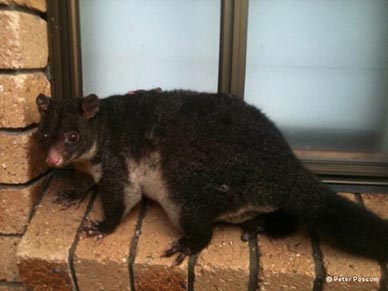1. ANIMAL DESCRIPTION
Common name: Mountain Brushtail Possum or Southern Bobuck
Scientific name: (Trichosurus cunninghami)
Fact: This species was not described as a separate species until 2002. It is found along the south east coastline of Australia.
SIZE
Adult size when fully grown is around 400 to 550 mm body length. Tail length is anywhere from 340 to 420 mm.
WEIGHT
Adult weight when fully grown is around 2.5 to 4.5 kilograms.
COAT
Their coat is predominantly covered in a soft steely grey or olive coloured fur. The Mountain Brushtail or Bobuck varies in colour, it can be black, dark brown, coffee brown and light grey coats. The front chest area of the possum can be white and contain a yellow staining. The coat is also denser than the common brushtail possum.
FEATURES
It is a nocturnal marsupial. Its ears are small and round compared to the more pointed ears of a ‘common’ brushtail possum species. That is the most obvious distinguishing feature.
It also has, a very strong tail. The tail is its most useful ‘tool’ when climbing trees. It acts as a ‘fifth’ arm / leg to allow quick and safe movement through the tree canopy by wrapping around branches.
Many of the other features of the Mountain Possum are the same as the Common Brushtail. The female has a pouch located on her abdominal region for the gestation of the young. The male of the species has scent glands located under his chin, down his chest and near the anal area specifically designed to allow him to mark his territory with his strong individual scent. The chest scent glands are most prevalent during the mating season when it darkens to a yellow ‘stained’ area along the lighter chest fur.

Mountain Brushtail
2. ECOLOGY
The Mountain Brushtail is found in the highland areas of south east Australia usually 300 metres above sea level. They are found from the Alps of Victoria to the tip of south east Queensland along the Great Dividing Range. They are not unusual in the forest ridges behind the Gold Coast and there is a small colony of unknown size in Western Brisbane.
It is described as a semi-arboreal tree dweller meaning it spends time in trees and on the ground. They shelter in the hollow limbs in trees and hollow logs but they have been found to inhabit dense scrub and undergrowth. They utilize plant debris such as leaves and bark to line their dens during the breeding season.
Like most possums, they are nocturnal and so will emerge at night to forage for food. The Mountain Possum depends primarily upon the Acacia tree species for its diet. The main Acacia species favoured is reported to be the Silver Wattle but possums in the Gippsland region of Australia tend to have no preference with any particular type of vegetation.
3. BEHAVIOUR
The Mountain Possum communicates with other possums vocally with calls varying from a deep chest boisterous cackling coughing sounds and high pitched staccato to hissing noises. These sounds are usually a threatening ‘be warned’ to other possums that may be encroaching upon the possum’s territory. The sounds are loud and full of energy.
Possums can also communicate with their scent glands in a passive way. Other possums will scent spread on trees and branches after rubbing its chest on selective areas.
The mother will share her den with a daughter but only while the daughter is relatively young. In forest areas, the young males have been found to disperse up to 8 km from their original birth home to establish their own territory. Upon reaching reproductive maturity, they will retain the same home range territory for life.
Good den sites are usually hard to find hence the competition amongst possums to keep their den and territory. They are very aggressive fighters when confronted by other possums. They have no hesitation in biting and clawing an opposing possum. The common injuries a possum will inflict are cuts and abrasions including puncture wounds and gouged hair and skin tears.
During the mating season the males will work hard to attract a number of females. It has been documented that it has taken the male a month of courtship before the female has become comfortable enough to allow breeding to take place.
4. BREEDING
The Mountain Brushtail’s breeding season occurs during March to June with breeding over a 2 to 3 week period. The female will produce a solitary young.
Females have a standard gestation period of only 16 to 18 days. The single young that they give birth to measures a tiny 15mm long and weighs around 2 grams. After the mother gives birth the baby instinctively crawls from the birth area over the abdominal fur and into the pouch.
In the pouch the very young baby is called a ‘pinkie’. The name ‘pinkie’ lasts until the baby develops fur and seals its mouth round the mother’s teat. The ‘pinkie’ stays in the pouch until its fur develops into a full coat. The possum then moves onto the mother’s back at the age of around 3 to 4 months and either rides with the mother on her back or is left in the safety of the den while the mother hunts for food. After seven to nine months the young possum will be mature enough to leave the comfort of the mother and face the world on its own and claim its own territory.
It has been observed that both the males and the females will not reproduce until they are at least two years of age.
Mountain and Common Brushtail differences: Behaviour
The common brushtail has been noted as a very flexible feeder when selecting its food sources. It will dine upon eucalypt trees but also a vast range of trees and plants that exist in its territorial area. The common brushtail will also eat insects and other small animals it finds when foraging. The mountain brushtail however is more selective with its behaviour when feeding. It has been recorded as being a solely herbivore feeder i.e. it does not eat insects or small animals ( normally although it has been known to eat animals on rare occasions ). Its main food sources are found upon the forest floor or in the shrub zone up to 2 metres which is the typical zone where tender shrubs exist including fruits and shoots, fungi species and fresh bark from trees.
Mountain and Common Brushtail differences: Ecology
The common brushtail is found throughout Australia in open forests, semi-arid and arid environments, tropical rainforests, woodlands including the urban built environment through all states and territories.
The mountain brushtail has a different geographical distribution. It is mainly found at high altitude along the Great Dividing Range on the east coast of Australia. It can be found solely amongst the tall damp rainforest trees in this zone. It does not reside in woodlands or open grassed plains. It prefers denser and thicker undergrowth in it’s chosen habitat and also prefers to live in scrub with many different and varied plant species. The mountain brushtail has been observed to prefer gullies in these rain forest areas and to avoid the more exposed high canopy trees.
Where the common brushtail can survive and adapt to almost any location the Mountain brushtail does not seem to boast these living skills. It has a preference for gullies with thick scrub that have been left undisturbed by man or other animal occupancy.
Mountain and Common Brushtail differences: Appearance
The differences in appearance between the common brushtail and the mountain are very distinct. The common brushtail has a furry grey coloured coat with a black wiry tail, large pointy ears and a pink nose. The mountain brushtail has distinctively smaller and rounded ears than the common brushtail. The mountain brushtail is also larger than the common possum weighing in around 500 to 1000 grams more depending on gender and habitat. The mountain version of the possum has a typically more slender tail with the fur tapering off towards the tip of the tail while the common’s wiry hair remains bushy down to the tip. When looking at a typical coat of the mountain brushtail it will tend to be an olive or mottled steel grey hue. The common brushtail will have a darker deeper grey colour with a thicker darker black tail. The mountain brushtail also has a shorter haired and thicker more dense coat than the common version.
5. HOME OWNER PROBLEMS
Peter the Possum man has caught a few Mountain Brushtail’s in traps set in the roof of houses in the western suburbs of Brisbane; so although this very leafy area is not particularly elevated, there is definitely a small population of them in that area. Apart from very dark coloured coats and contrasting paler fur on the chest, their smaller rounded ears confirm they are indeed Mountain Brushtail’s.
Due to the Mountain Possum’s assimilation into the built environment of the human population it has been labelled as a pest in some areas. It is known to cause damage to tree plantations and regenerating forests on an industrial scale and destroy gardens, flowers, fruit trees and the buildings that humans live and work in. In Queensland for instance the occurrence of possums in Brisbane is on the increase. The possum finds it very easy to locate food in built up areas from rubbish bins, litter, domestic gardens, fruit and native tree plantings and pet food bowls. This attracts the possum into residential areas due to the abundance of readily accessible food sources.
If a Mountain Possum is in a residential area we believe its behaviour is very similar to the Common Brushtail; it quickly seeks out warm, dry refuge for its den. The roof space and wall cavity of people’s houses and garages are ideal hiding places for the possum. They will have no hesitation in gnawing or clawing their way into a house or garage to find shelter. Possum removal becomes necessary for the concerned home owner.
6. SUMMARY – HOW CAN PETER THE POSSUM MAN HELP YOU?
The Mountain Possum in Brisbane suburbs is indeed a rarity but if it gets inside your home it can be both noisy and destructive so it is advisable to remove it.
By acting quickly and contacting Peter the Possum & Bird Man, a professional pest controller who specializes in catching possums and possum proofing, you can prevent expensive damage to your home. The pesky possum will be released nearby and you can even request a possum box to be installed in a nearby tree.
Every night the possum is an unwanted ‘tenant’ in your house, the chance of it doing more damage to the ceilings, roof insulation, roof sheeting and walls increases as it gets more comfortable in its new surrounds.
Call Peter the Possum Man and ask for your local Brisbane possum removalist. Our highly trained pest controllers and possum catchers will get rid of your unwanted possum guest promptly and efficiently. We have over 25 years of experience and we know all of the animal friendly techniques on how to remove an unwanted possum today.
We not only remove the possum with the best practices for animal welfare but we will also repair your house’s entry points by proofing as well. So not only do you say ‘good bye’ and get rid of the possum as an unwanted guest but your house is also repaired and made possum proof.
So once again – if you have a possum loose in your property, call Peter the Possum Man and ask for the friendliest Brisbane possum removalist.






